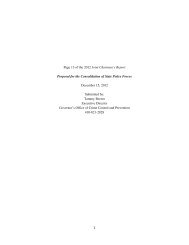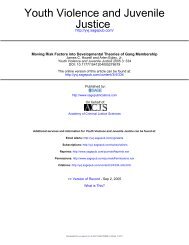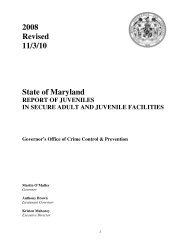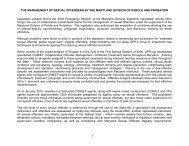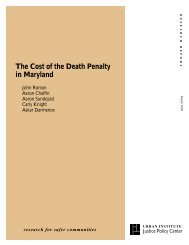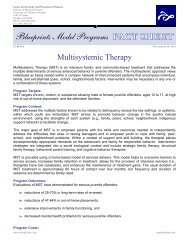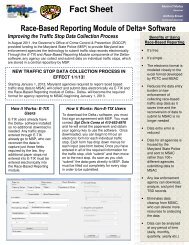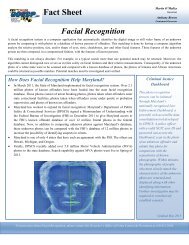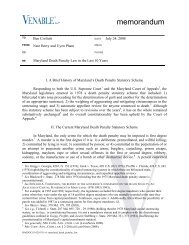Targeted Outreach - Governor's Office of Crime Control & Prevention ...
Targeted Outreach - Governor's Office of Crime Control & Prevention ...
Targeted Outreach - Governor's Office of Crime Control & Prevention ...
You also want an ePaper? Increase the reach of your titles
YUMPU automatically turns print PDFs into web optimized ePapers that Google loves.
Summary and Conclusion 41<br />
VI. Summary and Conclusion This evaluation looked at two initiatives developed<br />
by Boys & Girls Clubs <strong>of</strong> America and local Clubs.<br />
One initiative was designed to help youth stay out <strong>of</strong><br />
the gang lifestyle—Gang <strong>Prevention</strong> Through<br />
<strong>Targeted</strong> <strong>Outreach</strong>. The other was designed to help<br />
gang-involved youth change their negative behaviors<br />
and values—Gang Intervention Through <strong>Targeted</strong><br />
<strong>Outreach</strong>. In spite <strong>of</strong> challenges to the implementation<br />
<strong>of</strong> GPTTO and GITTO, the overarching philosophy<br />
<strong>of</strong> building relationships and establishing a<br />
place where youth feel they belong and are safe<br />
appears to be paying <strong>of</strong>f. The Clubs are reaching the<br />
youth whom they set out to reach and keeping them<br />
involved. One year into their tenure at the Clubs,<br />
youth are deriving positive developmental benefits<br />
and showing some indications <strong>of</strong> positive changes in<br />
gang, delinquent, school and relationship behaviors,<br />
and attitudes.<br />
This chapter summarizes the key findings in relation<br />
to the four major research questions asked at the<br />
beginning <strong>of</strong> this report. It also introduces an analysis<br />
<strong>of</strong> how much Clubs spent to implement GPTTO<br />
and GITTO for one year. Final thoughts on what<br />
these results mean for other initiatives are discussed.<br />
By Utilizing Club Staff Time Outside <strong>of</strong><br />
the Club for Direct <strong>Outreach</strong> and<br />
Building a Network <strong>of</strong> Referral<br />
Agencies, Clubs Reached a High-Risk<br />
Population <strong>of</strong> Youth that is Typically<br />
Underserved<br />
<strong>Prevention</strong> Clubs drew in a significant number <strong>of</strong><br />
new youth (on average, 44 youth) who were at high<br />
risk <strong>of</strong> gang involvement based on indicators such as<br />
their level <strong>of</strong> association with negative peers, poor<br />
academic histories, and prior involvement in illegal<br />
and delinquent activities. Intervention Clubs were<br />
also successful in attracting new youth (34, on average),<br />
a majority <strong>of</strong> whom were already gang members<br />
or were demonstrating gang behaviors.<br />
Comparisons <strong>of</strong> the risk factors (e.g., delinquent<br />
behaviors) <strong>of</strong> both prevention and intervention<br />
youth to other national studies <strong>of</strong> youth show that<br />
the Clubs are reaching youth with considerable<br />
needs. These youth are also older, on average, than<br />
are the typical Club or youth-serving organization<br />
participant (48 percent <strong>of</strong> prevention and 96 percent



